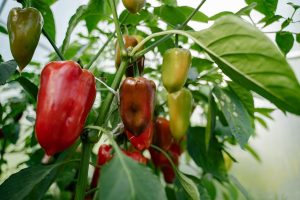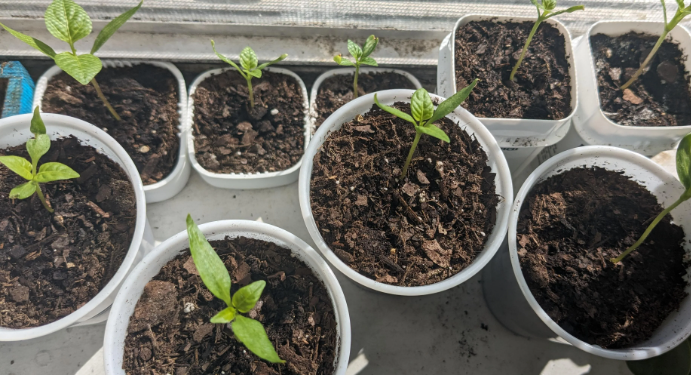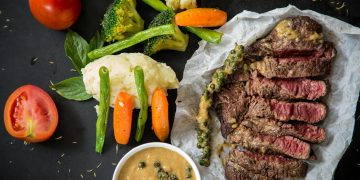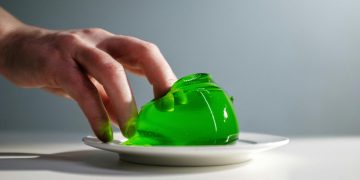Bell peppers are a beloved garden staple known for their pretty colors and nutrition. Native to Central and South America, Capsicum annuum was one of the first crops cultivated by early civilizations. Now grown worldwide, bell peppers offer a rainbow of color, flavor, and cooking possibilities.
Whether you dream of crisp green bells, fiery orange habaneros, or yummy purple bell peppers, understanding the growth stages of peppers is key to a successful harvest. Let's take a closer look at the life cycle of these prolific plants.
The 7 Growing Stages of Bell Peppers
1. Germination
The first stage of growing a bell pepper is the germination stage. It typically lasts about 7 to 10 days. The ideal soil temperature for bell pepper seeds is 70-90°F. Once you ensure the soil temperature is accurate, maintain consistent moisture by misting planting trays daily. But make sure it doesn’t get soggy.
For a headstart, sow seeds indoors 6-8 weeks before your last expected spring frost. In the proper conditions, sprouting will occur within 1-3 weeks.
2. Seedling Stage
The second stage is the seedling stage, which usually lasts around 1 to 4 weeks. Once sprouted, move seedling trays under bright grow lights 2-3″ away. Always ensure that the seedlings receive 14-16 hours of light exposure daily as they grow.
Run a small oscillating fan nearby to strengthen stems and prevent legginess. Usually, the thin seedlings are crowded to the 1st sturdiest plant per cell or pot.
3. Vegetative Growth
In case you didn’t know, bell papers grow in bushy plants. The vegetation growth happens in about 4 to 6 weeks. Gradually harden off pepper seedlings over 7-10 days before transplanting outdoors. When planting outdoors, space young plants 18-24″ apart in nutrient-rich and well-draining soil (pH 6.0-6.8).
Follow up by feeding every 2 weeks with an organic vegetable fertilizer formulated for flowering crops. Use sturdy 5′ tomato cages or stakes to support the height of the bushy pepper plants.
Also Read: Plum vs Pluot: Key Differences Unveiled!
4. Flowering

Flowering is the next stage of the growth of bell peppers, and they happen in about 8 to 10 weeks. This stage means that the plants you planted are happy in the conditions they were planted in, and so they’re ready to reproduce.
While self-pollinating, pepper flowers still benefit from bee visits. So, welcome them. Switch to a low-nitrogen, high-phosphorus fertilizer to promote bloom growth.
Aim to maintain consistent soil moisture, allowing the top inch to dry between watering. Daytime temperatures of 70-85°F are ideal; intense 90°F+ heat risks blossom drop.
5. Pollination
Peppers are self-fertile, and a single flower can pollinate itself without the help of insects. Pollination happens in the next 1 to 2 weeks after the flowering stage. Always remember that the pollen release is most successful in low humidity with good airflow. On calm mornings, gently tap flower clusters to release more pollen.
Also, run an oscillating fan in greenhouses to improve indoor pollination. Self-pollination allows fruit to set even if nighttime temperatures drop.
Also Read: Jalapeno Plant Stages: Step by Step From Seed to Harvest
6. Fruiting

Early fruiting can happen even 5 to 10 days after pollination. Once the bell pepper enters the fruiting stage, feed it with calcium and potassium-rich fertilizer every 2 weeks.
When it comes to the largest peppers, prune to focus energy on just 5-8 fruits per plant. Make sure to scout often for pests; hand-pick them or apply insecticidal soap/neem oil. Also, water the bell pepper plant consistently. Inconsistent watering leads to blossom end rot, bitterness, and cat-facing.
7. Ripening
Here is what you patiently waited for since the germination of the seeds. Your bell peppers are ripening. The days to maturity usually vary from 60-95 days. You can either harvest them green or leave them to ripen fully.
It is beautiful to watch the green bells slowly transform into shades of red, orange, yellow, and purple over 2+ weeks. Allow to ripen for peak sweetness, vitamin content, and distinct flavors.
Snip ripe peppers with clean shears, leaving a short 1/2″ stem attached.
Learn About Pitaya vs Pitahaya Fruit: Unveiling the Major Differences
Optimal Growing Conditions
- Full sun, receiving 6+ hours of direct light daily
- Daytime 70-85°F, nighttime above 60°F
- Consistently moist but well-drained soil; raised beds deter soggy roots
- Nutrient-dense compost or potting mix formulated for vegetables
- 2-3″ organic mulch like shredded leaves to conserve moisture
- Regular pruning of yellow leaves, suckers, spent blooms
Preventing Pests & Disease
With the right care specific to each growth stage, you can nurture a prolific pepper patch overflowing with yummy, colorful fruits. So, taking steps to prevent pests and diseases is important.
What to use? |
How to use it? |
Aphids |
Spray away with water or apply insecticidal soap |
Whiteflies |
Use sticky traps and introduce natural predators |
Spider mites |
Keep humidity high with regular misting |
Bacterial leaf spot |
Improve air circulation, dispose of debris |
Anthracnose |
Avoid overhead watering, apply organic fungicide |
Start planning your bell pepper garden today for a vibrant, versatile, and healthy harvest all season long!
Frequently Asked Questions
1. How many days until I can pick bell peppers?
Most varieties mature in 60-90 days from transplant to harvest. Check your seed packet for the specific days to maturity.
2. What's the typical pepper yield per plant?
With proper growing conditions, expect 6-10 full-sized fruits from each healthy pepper plant over the season.
3. Can peppers be grown in containers?
Absolutely! Select a patio or bush variety and plant in a 12″+ wide pot with a high-quality potting mix designed for vegetables.
4. What causes blossom end rot on my peppers?
This disorder stems from a calcium deficiency due to uneven watering. Always maintain consistent soil moisture and use mulch.
5. Why do green peppers turn red over time?
As they mature, green bell peppers naturally ripen into yellow, orange, red or purple hues. This intensifies their sweetness and vitamin content.
Also Read: The 7 Cucumber Growing Stages Explained: From Seed to Salad
Final Thought
Cultivating the food you eat with your own too hands is a beautiful feeling. Also, by doing so, you have complete control over what enters your body. That is a blessing in today’s world. I hope this guide to the life cycle and growth stages of bell peppers helps you cultivate a beautiful and bountiful harvest! Let me know if you have any other questions.


























